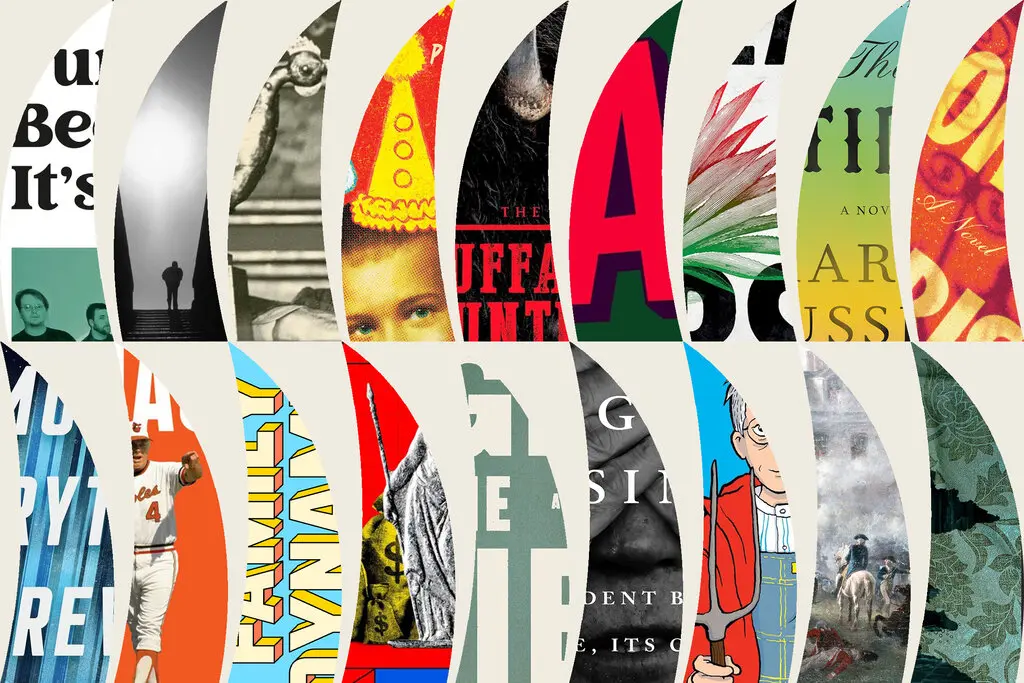For the dad who’s still talking about “The Americans” finale
Image

The Illegals, by Shaun Walker
Walker’s fascinating and meticulously researched book details a century-long Russian project to infiltrate Western society by planting deep-cover spies — or “illegals” — to live for decades under false American identities in places like Hoboken, N.J. The program began in 1922, when Lenin was still pacing the Kremlin corridors, and continues today under Putin, who has seldom met a Soviet relic he didn’t want to polish up. Read our review.
Also consider: “The Determined Spy: The Turbulent Life and Times of CIA Pioneer Frank Wisner,” by Douglas Waller; “Watching the Jackals: Prague’s Covert Liaisons With Cold War Terrorists and Revolutionaries,” by Daniela Richterova; “The Torqued Man,” by Peter Mann
For the dad who loves thrillers
Image

The Doorman, by Chris Pavone
Pavone is the author of five previous books, literary thrillers characterized by elegant writing and intricate plotting. This is something bigger in tone and ambition. While a mystery hums beneath the narrative — we know from the early pages that somebody won’t make it out alive — “The Doorman” is better read as a state-of-the-city novel, a kaleidoscopic portrait of New York at a singularly strange moment. Read our review.
Also consider: “Never Flinch,” by Stephen King; “Dead Money,” by Jakob Kerr; “Your Steps on the Stairs,” by Antonio Muñoz Molina; “Ruth Run,” by Elizabeth Kaufman
For the dad who likes comics and graphic novels
Image

Spent
by Alison Bechdel
In this gently satirical graphic novel, Bechdel traces the life of a writer worried about selling out. Though it’s the lightest of comedies, the book’s biggest question is a laudably difficult one: Can you be a good progressive if you’re a safe and privileged member of the upper middle class in a society tainted by oppression and selfishness? Bechdel keeps the jokes coming at the pace of a good “Simpsons” episode, and her genuine affection for her characters gives “Spent” a sweetness that makes even its cheapest shots feel good-natured. Read our review.
Also consider: “Crumb: A Cartoonist’s Life,” by Dan Nadel; “Life Drawing,” by Jaime Hernandez; “Tongues,” by Anders Nilsen; “Bowling With Corpses,” by Mike Mignola
For the Revolutionary War dad
Image

The Fate of the Day, by Rick Atkinson
There is no better writer of narrative history than the Pulitzer Prize-winning Atkinson, who is able to transport readers to a different time and place without minimizing the differences of the past from the present. This book — the second in his planned trilogy about the American Revolution — is so compulsively readable that it’s hard to put down. Read our review.
Also consider: “Embers of the Hands: Hidden Histories of the Viking Age,” by Eleanor Barraclough; “America, América: A New History of the New World,” by Greg Grandin; “The Prosecutor: One Man’s Battle to Bring Nazis to Justice,” by Jack Fairweather
For the dad who’s a science buff
Image

The Family Dynamic, by Susan Dominus
Dominus, a staff writer at The New York Times Magazine, set out to elucidate the commonalities among families that had “more than one high-achieving child.” She expertly interweaves stories of the Brontë sisters with those of contemporary families and academic studies. What emerges from all of her vignettes is no formula but a portrait of the complex interaction between nature, nurture and luck. Read our review.
Also consider: “Proof: The Art and Science of Certainty,” by Adam Kucharski; “A Crack in Everything: How Black Holes Came In From the Cold and Took Cosmic Centre Stage,” by Marcus Chown; “Cerebral Entanglements: How the Brain Shapes Our Public and Private Lives,” by Allan J. Hamilton
For the dad who likes biographies and memoirs
Image

Tequila Wars, by Ted Genoways
José Cuervo’s name has become synonymous with tequila, but — as Genoways notes in this textured and densely packed biography — “many people today do not even realize he was a real person.” By drawing on family, newspaper, government and university archives, as well as the extant scraps of Cuervo’s professional and personal correspondence, Genoways is able to paint a nuanced portrait of an elusive figure and ensure that he will live on as more than just a brand name. Read our review.
Also consider: “Raising Hare,” by Chloe Dalton; “The Trouble of Color: An American Family Memoir,” by Martha S. Jones; “Careless People: A Cautionary Tale of Power, Greed, and Lost Idealism,” by Sarah Wynn-Williams
For the dad who enjoys historical fiction
Image

Fagin the Thief, by Allison Epstein
You might be surprised to learn that Oliver Twist has nothing more than a walk-on part in “Fagin the Thief.” And even more surprised to learn that Dickens’s notorious villain emerges from this reimagining of his origins as indelibly shaped by the prejudices of 19th-century London, where even as a boy he suffers “the natural consequence of being visibly Jewish and visibly poor.” Epstein has created a deeply nuanced character, understandable if not wildly sympathetic. Read our review.
Also consider: “The Café With No Name,” by Robert Seethaler; “To Save the Man,” by John Sayles; “The Pretender,” by Jo Harkin
For the dad who’s a tech nerd
Image

More Everything Forever, by Adam Becker
This smart and wonderfully readable new book traces the various plans advanced by billionaire tech entrepreneurs to “save humanity.” From artificial intelligence to colonizing outer space, the animating force behind such projects is what Becker calls “the ideology of technological salvation.” He argues that Silicon Valley’s preoccupations have created their own kind of warped ethics, offering transcendence without regard for practical limits or conventional morality. Read our review.
Also consider: “Apple in China: The Capture of the World’s Greatest Company,” by Patrick McGee; “Empire of AI: Dreams and Nightmares in Sam Altman’s OpenAI,” by Karen Hao; “Unit X: How the Pentagon and Silicon Valley Are Transforming the Future of War,” by Raj M. Shah and Christopher Kirchhoff
For the dad who loves a mystery
Image

In this nod to classic 1920s detective fiction, a group of friends convenes for an overnight murder mystery party in an Irish country house on New Year’s Eve, and each guest is assigned a part by the hostess. As in any locked-room mystery — for that is what Hegarty’s terrific novel at first seems to be — real death comes unbidden to the house. Read our review.
Also consider: Marble Hall Murders, by Anthony Horowitz; The Mystery of the Crooked Man, by Tom Spencer; “The Best Enemy,” by Sergio Olguín
For the dad who’s all business
Image

Meltdown, by Duncan Mavin
The story of Credit Suisse is an impressive dossier of sleaze, full of petty, pointless squabbles that unfold on the edge of legality. It’s not exactly an epic of corporate hubris, nor quite a morality play of corporate greed, but a procession of grifts and mistakes, repeated for decades. Read our review.
Also consider: Little Bosses Everywhere: How the Pyramid Scheme Shaped America, by Bridget Read; Empty Vessel: The Story of the Global Economy in One Barge, by Ian Kumekawa; The Killing Fields of East New York: The First Subprime Mortgage Scandal, a White-Collar Crime Spree, and the Collapse of an American Neighborhood, by Stacy Horn
For the dad who’s a politics buff
Image

Original Sin, by Jake Tapper and Alex Thompson
Tapper, an anchor at CNN, served as a moderator for the 2024 presidential debate that highlighted a faltering Joe Biden, starting a cascade of criticism that eventually led Biden to withdraw from the race. Here, Tapper and the Axios political reporter Thompson offer a damning, step-by-step account of how the people closest to a stubborn, aging president enabled his quixotic resolve to run for a second term. Read our review.
Also consider: “Death Is Our Business: Russian Mercenaries and the New Era of Private Armies,” by John Lechner; “Red Scare: Blacklists, McCarthyism, and the Making of Modern America,” by Clay Risen; “The Ideological Brain: The Radical Science of Flexible Thinking,” by Leor Zmigrod
For the dad who’s a sports fan
Image

The Last Manager, by John W. Miller
Miller’s vivid biography captures the banty, blustering genius of Earl Weaver, who as the Baltimore Orioles manager in the 1970s and beyond was famous for his hot temper, theatrical antics and — not least — his impressively winning strategies. Read our review.
Also consider: “The New York Game: Baseball and the Rise of a New City,” by Kevin Baker; “There’s Always This Year: On Basketball and Ascension,” by Hanif Abdurraqib; “To Smithereens,” by Rosalyn Drexler
For the dad who likes horror
Image

The Buffalo Hunter Hunter, by Stephen Graham Jones
Jones’s past fiction has confidently mashed up various horror genres with pointed explorations of Native American experience, and his new novel follows suit — via a Blackfeet man who becomes a vampire and seeks vengeance for the country’s sins. Read our review.
Also consider: “Victorian Psycho,” by Virginia Feito; “Sour Cherry,” by Natalia Theodoridou; “Beta Vulgaris,” by Margie Sarsfield
For the dad who’s a pop culture junkie
Image

Funny Because It’s True, by Christine Wenc
An idiosyncratic, thoroughly enjoyable history of The Onion, the scrappy publication that made the media its chief satirical target. From the beginning, readers have been fooled, perhaps most notoriously a Republican congressman who reposted “Planned Parenthood Opens $8 Billion Abortionplex” on his Facebook page in 2011. Read our review.
Also consider: “The Golden Hour: A Story of Family and Power in Hollywood,” by Matthew Specktor; “When the Going Was Good: An Editor’s Adventures During the Last Golden Age of Magazines,” by Graydon Carter with James Fox; “Who Knew,” by Barry Diller
For the dad who likes to laugh
Image

Class Clown, by Dave Barry
As one of the great syndicated newspaper columnists of the 1980s, Barry always brought a laugh-out-loud element to his work. This memoir shows that, even though he’s now well into his 70s, his prose style hasn’t matured, thank heavens. It’s as ideally sophomoric as ever, if more rueful around the edges, what with civilization aflame and all. As funny books go, “Class Clown” is a home run. Read our review.
Also consider: “Fever Beach,” by Carl Hiaasen; “Hot Air,” by Marcy Dermansky; “Colored Television,” by Danzy Senna
For the dad with multiple museum memberships
Image

The Maverick’s Museum, by Blake Gopnik
Gopnik’s vivid, engrossing biography of the art-world contrarian Albert C. Barnes — the man behind the venerated Barnes Collection in Philadelphia — presents him as contradictory, intriguing and often infuriating. In Gopnik’s words, Barnes was a “tyrannical egalitarian,” a “patriarchal feminist” and a “Gilded Age progressive” who was committed to bringing art to the American people. Read our review.
Also consider: “Rogues and Scholars: A History of the London Art World: 1945-2000,” by James Stourton; “All That Glitters: A Tale of Friendship, Fraud, and Fine Art,” by Orlando Whitfield; “The Work of Art: How Something Comes From Nothing,” by Adam Moss
For the dad who likes speculative fiction
Image

The Antidote, by Karen Russell
“The Antidote” opens in the aftermath of the Black Sunday dust storm of April 14, 1935, when a sunny afternoon suddenly turned darker than night, and the Great Plains became known as the Dust Bowl. To tell the story, Russell blends rich language and vivid characters with fantasy elements — not to escape reality, but to comment even more thoughtfully on it. How do you comprehend the enormity of an entire region of crops suddenly dying? All the lives upended, seemingly overnight? Sometimes you need to invoke the impossible to capture the truth. Read our review.
Also consider: “The Book of Records,” by Madeleine Thien; “Dissolution,” by Nicholas Binge; “Brother Brontë,” by Fernando A. Flores; “Darkmotherland,” by Samrat Upadhyay
For the dad who’s a true crime buff
Image

The Peepshow, by Kate Summerscale
The stranger-than-fiction case unpacks a series of sensational murders that rocked 1950s London. Summerscale brings a novelist’s eye and a sociologist’s understanding to a trove of thrilling material. Read our review.

